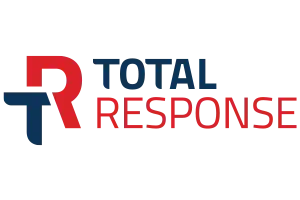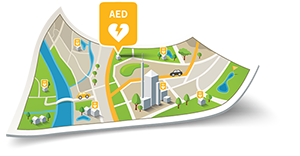Tagged with: Automated External Defibrillator Registry
April 28, 2025
What to know to save a life: The key to cardiac arrest survival
Bystander training on spotting and using defibrillators can greatly improve cardiac arrest survival, but many people don’t know what to do.
When a woman collapsed on an escalator at the Buffalo airport last June, Phil Clough knew what to do. He and another bystander put her flat on her back and checked her pulse and her breathing. Then she stopped breathing altogether. Realizing that she might be having a cardiac arrest, Clough immediately started doing chest compressions, pressing hard and quickly on the center of her chest, while others nearby called 911 and ran to get an automated external defibrillator. Within seconds of receiving a shock from the AED, the woman opened her eyes. By the time the airport rescue team arrived a few minutes later, she was conscious and able to talk with rescuers.
Filed Under: News, Highlights | Tagged With: AED, CPR, cardiac arrest, Defibrillator, Defibrillator Registry, Michelle Andrews, Phil Clough, 911, Automated External Defibrillator, Automated External Defibrillator Registry, American Heart Association, AHA, AED Locations, Cardiac Arrest Stats, Identifying AEDs, NEAR Registry, Nearby AED, 911 AED Registry, National AED registry, National Emergency AED Registry, AED Registry, AED Response, AED Responder, AED Map, PulsePoint AED, PulsePoint AED Registry, Elijah White, ZOLL, CPR Training, Good Samaritan, AED Law, AED Training, Citizen CPR Foundation, citizen responder, HEARTsafe, 911 Telecommunicators, T-CPR, T-AED, AED-Needed Alerts

August 2, 2024
The Life-Saving Potential of 911-Initiated AED Response
In the initial moments after a cardiac arrest, seconds truly matter. Prompt deployment of an Automated External Defibrillator (AED) can be the difference between life and death. But the presence of a nearby AED may not be known to the caller or the emergency telecommunicator. Similar to providing cardiopulmonary resuscitation instruction (T-CPR), equipping telecommunicators with automated external defibrillator locations (T-AED) can improve outcomes. The PulsePoint Emergency AED Registry is accessible to telecommunicators through integrations with industry partners like PowerPhone.
Filed Under: News, Highlights | Tagged With: Automated External Defibrillator, Automated External Defibrillator Registry, AED, Emergency Telecommunicators, T-CPR, T-AED, Emergency AED Registry, PowerPhone, Total Response, Pre-arrival Instructions, EMD, EMD AED, EMD AED Registry, Emergency Medical Dispatch, PulsePoint AED, PulsePoint AED Registry, community AEDs, cardiac arrest, Sudden Cardiac Arrest, Sudden Cardiac Arrest AED, emergency dispatch center, PSAP, PSAP AED Registry, AED-Needed Alerts, AED registries, The Villages, Sumter County, neighbors needing defibrillators, Stephen Kennedy, 911 AED, 911 AED Registry, residential AED initiative, CARES, public AED network

January 7, 2021
Emergency Telecommunicators Need Access to a Community AED Registry
Public Safety Answering Point (PSAP) telecommunicators are a critical link in the cardiac arrest chain of survival. Placing the proper tools in their hands can improve outcomes.
The PulsePoint Foundation provides PSAP technology to make "Is there an AED nearby?" an unnecessary question during cardiac arrest call processing while also advocating for broad adoption of this lifesaving capability. Our goal is for the telecommunicator to instead inform the caller of the location of nearby AEDs. Consider how much more effective it would be to say, “there is an AED at that store,” and direct the caller to “send someone to retrieve the AED from the customer service counter,” as CPR instructions begin? We back our advocacy and commitment with comprehensive and accessible resources. By providing exceptional, industry-supported AED registry solutions at no cost—and we genuinely mean free in all aspects—we strive to remove deployment impediments.
Filed Under: News, Highlights | Tagged With: AED Registry, AED, aed.new, 911 AED, AED Registry for dispatchers, Add an AED, Register an AED, FirstNet AED, AED Registry app, Nearby AED, Nearest AED, Dispatch recommend AED, Dispatcher recommended AED, Find AED, Locate AED, Source AED, Hosted AED Registry, Browser-based AED Registry, Cloud AED Registry, AED Management, AED Registry Management, Community AED Registry, Telecommunicator AED, Emergency Telecommunicators, ECC AED, Free AED Registry, No cost AED Registry, ProQA, ProQA AED Registry, Paramount AED Registry, Priority Dispatch AED, Priority Dispatch Registry, EMD AED, EMD AED Registry, Calltaker AED Registry, Call taker AED, AED Database, Cardiac Arrest AED, Sudden Cardiac Arrest AED, Where are AEDs located, Automated External Defibrillator Registry, Defibrillator Registry, Track AEDs, PAD Registry, Public Access Defibrillator, PAD AED Registry, Enhanced 9-1-1 AED, NG AED, NG Registry for AED, Find an AED, HeartSafe AED Registry, HeartSafe AED, National AED registry, AED Locator, AED Link, AED Registry Database, Priority Dispatch ProQA Paramount, Register a new AED, PSAP AED Registry, AED Registration, Tracking AEDs, Link AEDs, Online AED Registration, AED Program Management, AED Program Registry, AED Management Software, AED Log, AED Program